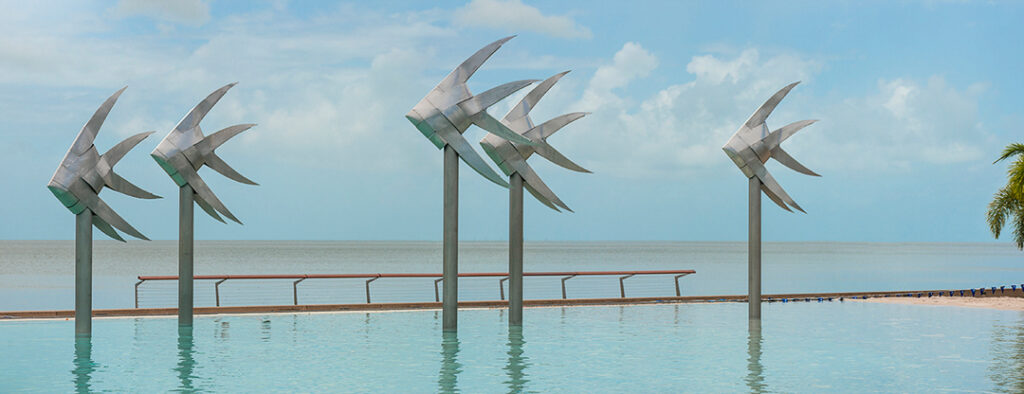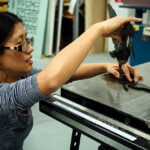
Brian Robinson’s Woven Fish, fashion from stainless steel and installed on the Cairns Esplanade in 2003, has stood the test of time; photo supplied
Pamela See writes about public works by Brian Robinson, Bruce Reynolds and Judy Watson where the making is part of the message.
(A message to the reader.)
The development of a civilisation might be measured by the state of its arts. A primary example is the capacity to commit resources to building big sculptures, which serve purposes that are non-material. The first human settlement, in modern-day Turkey, produced not only a temple but also an 180-cm tall sculpture. “Ur Man”, named in reference to the state of Ur, is depicted holding his phallus. Carved from limestone and dating back to the ninth century BCE, the figure even has a subterranean foundation which enabled him to freestand. This might be considered a feat of engineering for neolithic man.
At the turn of the twenty-first century, Art Built-in was adopted by the Queensland government as a coordinated approach to commissioning public art. “Art practice that occurs outside” of the gallery and museum sector, was the definition officially offered in policy documents. This slate in the state was comparatively clean, notwithstanding memorials to politicians and soldiers or “big” roadside renditions of crops and livestock.
A department would be dedicated to the distribution of funds, which were acquired from a mandatory two per cent allocation of all capital works budgets over $250,000. Espoused was the desire to generate opportunities for artists, designers and craftspeople. Its intended purpose was to foster the creation of art that encapsulated the “natural” and “cultural” histories of the sites. “Built-in” entailed the engagement of “artists” in “project development teams” from “the outset of capital works planning and delivery”. The outcomes specified were inclusive of not only “sculpture, painting, or installation” but also “filing and storage items, lighting, door handles [and] carpet”.
Regrettably, the reception was less than favourable, with art historian Rex Butler labelling the results as “bogus” and “bland”. Amongst the reasons cited were the requirements imposed by committees for the site augmentations to be accessible, affordable and apolitical. It would be difficult to dispute this appraisal. However, the short-lived policy may have had some positive implications for craft practice within the state.
Woven Fish (2003) by Brian Robinson remains a beacon for tourists. The fountains entered the physical and cultural landscape, through the redevelopment of the Cairns Esplanade. In his design, the Maluyligal and Wuthathi artist drew on his upbringing on Waiben (Thursday Island). There, woven coconut palm fronds served a diversity of purposes. These included the construction of: baskets for carrying fish, mats for flooring, and sails for outrigger canoes. This ancient aesthetic, which embodies the enduring resourcefulness and ingenuity of his people, was applied to contemporary stainless steel sheet fabrication.
Art Built-in sought to simultaneously embrace both, in the rhetoric of William Morris’s nineteenth-century Art and Craft Movement (ACM), the greater and lesser arts. This policy created pedestals for craft practice. The commissions exposed exquisite beauty in forms that might have otherwise remained unseen due to their ubiquity.
After eight years, it was superseded by the Art+Place program, but many of its governing principles were maintained. The change in policy included the pooling of resources across capital works into a 12 million dollar “global” “Public Art Fund”, which was managed by a state curator in consultation with a panel. An extension in scope enabled both the purchase of existing artworks and the embellishment of established precincts.

A sculptural component of Bruce Reynold’s Pamphlet series, installed in and around the Brisbane Exhibition and Convention Centre in 2010
The Pamphlet (2012) series was built in and about the Brisbane Exhibition and Convention Centre as part of its expansion onto Grey Street. The Australian-born artist with Nigerian heritage, Bruce Reynolds, signposts the significant, yet unsung role, played by Thomas Pamphlet. In the early nineteenth century, the former convict was tasked by John Oxley with taking him to the Brisbane River. This led to the establishment of the Moreton Bay Penal Colony, in which Pamphlet would later be incarcerated. The natural and social histories of the site are investigated through sculpture, hand-carved polyethylene, and linoleum collage.
The invention of linoleum occurred in England during the ACM. In the Victorian Era, the surfaces of furniture were decorated with decoupage. Parity could be found in Reynolds’ adornment of polyhedral forms with vitreous enamel prints. They depict the vicinity from an aerial perspective and linoleum patterns from “houses being renovated”. The characteristic style of housing referred to as Queenslanders, also evolved in the nineteenth century. The artist established his career by collaging the linoleum flooring he reclaimed from them. Pamphlet also chronicles change from colonial to contemporary times, including making reference to the 2010 Brisbane flood, which inundated South Brisbane.

Judy Watson’s tow row, cast in bronze, was installed at the entrance of the Gallery of Modern Art in 2016
Since 2010, the information released by the Queensland government about its funding of public art has been limited. However, tow row (2016), which it partially funded, appears to have set a gold standard in public art for the state. The bronze sculpture is permanently positioned at the entrance of the Gallery of Modern Art (GOMA).
Waanyi artist, Judy Watson, drew inspiration from a style of “butterfly” fishing net woven by First Nations women. Although known as “tow row” in South-East Queensland, different versions are utilised in “other places” including Waanyi Country in North-West Queensland. Watson recounted seeing, “…one used on a remote outstation near Maningrida when I was working with the women at the community up there in the late 1990’s.” In turn, Watson invited Quandamooka emerging artist Elisa Jane Carmichael to fashion a net from “string” that she and multiple people collectively made with raffia and jersey material. It was then positioned across Watson’s sculptural form and cast. According to Watson, the delicate appearance of these nets belies their “hidden” strength. She has engaged this form as a symbol for the “resilience” of First Nations people amidst “adversity”.
From “Ur Man” to obelisks, the capacity to craft monumental, non-utilitarian structures, appears a litmus of cultural development. The Queensland government may have, arguably, been a late arrival to this table. The initial outcomes of its policy were also met with resistance from its citizens. However, its controversial approach distinctly elevated functional forms with ethnographic value. In some cases, the engagement of endemic and traditional techniques of fabrication was symbolic. Whilst their effectiveness as art might be contentious, their service to craft in making spectacles of skills which are often overlooked, is clear. By this measure, public art in Queensland may have set a precedent.
Further reading
Art Gallery of New South Wales. (n.d.). Judy Watson. https://www.artgallery.nsw.gov.au/collection/artists/watson-judy/
Art Gallery of South Australia. (n.d.). Brian Robinson – Patterns & Pop Culture. https://www.agsa.sa.gov.au/education/resources-educators/resources-educators-themed/reconciliation-week/brian-robinson-patterns-and-pop-culture/
Arts Queensland. (2007). Art+Place: Policy Framework. Government Printer.
Arts Queensland. (2007). Queensland Public Art Fund: Guide for Applicants. Government Printer.
Australian Institute for Disaster Resilience. (n.d.). Queensland and Brisbane 2010-11 Floods. Australian Government. https://knowledge.aidr.org.au/resources/flood-queensland-2010-2011/
Betts, A. (2016, December 2). GOMA Turns 10: The Story Behind tow row, Judy Watsons’s Bronze Fishing Net Sculpture. ABC Radio National. https://www.abc.net.au/news/2016-12-02/tow-row-judy-watson-fishing-net-sculpture-goma-turns-10/8082646
Bevan, R. (2018, August 3). Turkey’s Göbekli Tepe: is this the World’s First Architecture? The Art Newspaper. https://www.theartnewspaper.com/2018/08/03/turkeys-gobekli-tepe-is-this-the-worlds-first-architecture
Brisbane Convention & Exhibition Centre. (n.d.). The BCEC Art Collection. https://www.bcec.com.au/visit/art-collection/
Butler, Rex W. (2003, June 7). Bogus Art: A Policy to Fund Public Art. The Courier Mail.
Contour 556. (2022). Bruce Reynolds. Canberra Art Biennial. https://canberraartbiennial.com/artist/bruce-reynolds/
Gross, L. (2018, March 19). The Evolution of Linoleum. Hagley Museum and Library. https://www.hagley.org/librarynews/evolution-linoleum
Hornibrook, J. H. (1967). Pamphlett, Thomas (1789–1838), Australian Dictionary of Biography. National University. https://adb.anu.edu.au/biography/pamphlett-thomas-2536/text3443
Indigenous Knowledge Institute. (n.d.). Weaving Designs into Local Materials. University of Melbourne. https://indigenousknowledge.unimelb.edu.au/curriculum/resources/weaving-design-into-local-materials
Martin-Chew, L. (2022). Bruce Reynolds Resists the Pretension of Art. Arts Guide Australia. https://artguide.com.au/bruce-reynolds-resists-the-pretension-of-art/
Martin-Chew, L. (2011). Profile: Mr Linoleum. Green: Sustainable Architecture and Landscape Design, (22), 18–20. https://search.informit.org/doi/10.3316/informit.543489061674053
McClean, B. (2017). The Story of Judy Watson’s ‘tow row’. https://blog.qagoma.qld.gov.au/the-story-of-judy-watsons-tow-row/
McNiven, I. (2015). Goemulgaw Lagal: Natural and Cultural Histories of the Island of Mabuyag, Torres Strait. In (Eds.McNiven, I., & Hitchcock, G.). Memoirs of the Queensland Museum. (Part 8. Volume 2.) Queensland Museum. https://www.museum.qld.gov.au/collections-and-research/memoirs/culture-8
Morris, W. (1882). “The Lesser Arts of Life”, in Lectures on Art Delivered in Support for the Society of Protection of Ancient Buildings (pp. 174-232). Macmillan and Co.
Newell, P. (1979). The Origins and Development of the Queensland House. Journal of the Royal Historical Society of Queensland, 10(4), 18-28.
Public Art Agency. (2004). Art Built-in Creating Better Public Places: Policy & Guidelines. Queensland Government.
Public Art Online. (n.d.). Art+Place. https://publicartonline.org.uk/resources/practicaladvice/policiesguidance/policies_outside_uk/artandplace.php.html
QAGOMA. (n.d.). Judy Watson ‘“tow row”. https://www.qagoma.qld.gov.au/exhibition/tow-row/
Turkish Museums. (2020, 17 August). Do You Know the World’s First Life-Sized Human Statue? https://turkishmuseums.com/blog/detail/do-you-know-the-world-s-first-life-sized-human-statue/10012/4
Urban Art Projects. (n.d.). Elisa Jane Carmichael. https://www.uapcompany.com/projects/water-is-life


